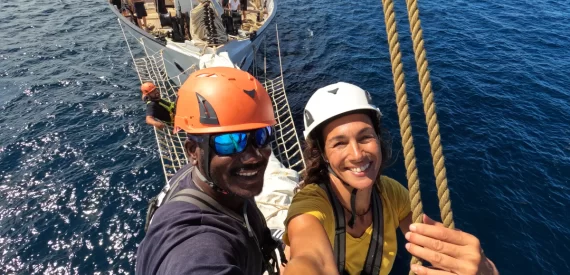You’ve found your ideal sailing adventure and had your booking confirmed. Now it’s time to arrange travel to and from your voyage. Where to start?
We have a look at where to get the best travel advice and how to keep your plans as environmentally friendly as possible.
Don’t Reinvent the Wheel!
Other sailors will have made the same journey before you, so it can be worth reaching out to connect with them. You can either ask the ship direct for travel advice to the ports you need, or join our Classic Sailing Sailors Facebook group and post a question.
We are also very happy to help where we can, and we can also highly (and independently) recommend DialAFlight, particularly for arrangements off the beaten track:
Tel: UK 020 7962 9933 and US 1 800 353 1451
You get to talk to a person, they provide you with an email quotation you can check out the options online for yourself. They also provide good choices for hotels.
Please do not book any flights or accommodation before your voyage has been confirmed. This is normally when you have paid the voyage fee or the deposit.

Green Travel
We can highly recommend the book ‘Sustainable Travel’ by Holly Tuppen to anyone concerned with making their adventuring as low-impact as possible. Some of the tips below are taken from this excellent resource.
Sailing is a very low user of carbon energy. Generally speaking the larger the vessel the more requirements they have for electronic navigation and safety equipment, food preservation and preparation, hygiene and maintenance tools. If you allocate this usage to the number of people onboard you will find it a tiny amount and less than your normal carbon usage ashore. So, whilst sailing you are probably reducing your carbon footprint.
HOWEVER, the elephant in the room is that many of the exciting voyages on offer require a flight (or two) to get there. This can tip the scales significantly, and we would urge all sailors to follow these tips to making their travel plans as environmentally friendly as possible.
Only Fly if Absolutely Necessary
Depending on your location, there may well be voyages that you can reach by train or coach, and we would encourage you to do so wherever possible. Don’t assume that a voyage halfway round the world will be more exciting than one on your doorstep. Seeing a familiar stretch of coastline from a new perspective can be incredibly rewarding, and the camaraderie of being part of the crew is the same wherever you sail.
Flying may also not be the only option to reach your voyage, even if it is an ocean away. If you have the time, you can look at travelling by cargo ship, ferry, or find another sailing voyage that bridges the gap.
If You Must Fly: Make the Most of It!
If you are set on a far-flung voyage, book as much time off work as possible and make it a trip to remember! Combine your sailing with some land-based exploration, soak up the local culture, take extra time in the arrival and departure ports and do some travelling by train or coach before returning home again. An epic adventure like this once a decade will do you (and the planet) more good than a middle-of-the-road foreign holiday every year.
Not All Flights are Created Equal…
If a flight is required, bear in mind that there are huge variations in emissions, and a bit of careful planning can help to reduce your carbon footprint as much as possible.
- Fly direct rather than doing short hops: emissions are much higher on take off and landing, so this can massively reduce your overall impact.
- Fly economy rather than business class: an economy passenger is responsible for around a quarter of the emissions of a business class passenger.
- Pack as lightly as possible: the impact of your luggage may be small, but if every passenger reduced their baggage weight the flight’s emissions would drop significantly.
- Fly during the day, rather than overnight: contrails produced by planes trap additional heat in the atmosphere, more than doubling the net warming effect of your flight. In the day, flights are 50% less likely to produce contrails. In addition, the warming effect is counteracted by the contrails reflecting sunlight. At night there is no such mitigating effect.
- Choose your airline carefully, and pick one with a real commitment to emission reduction. Skyscanner includes CO2 emission results in their search, and provides a quick-to-spot green leaf logo on the most efficient option for your journey. Consumer watchdog Which? conducted an interesting investigation into the impact your airline choice can have.
Carbon Offsetting
Carbon Offsetting can be seen as a quick fix. Sadly it is not that simple, and there are plenty of organisations out there with dodgy credentials, so be careful which company you choose. However, if you direct your money to the right place, offsetting can be incredibly valuable.
Many airlines offer their own ‘opt in’ offsetting scheme, but various investigations have found these to be largely inadequate. For an independent estimate of your carbon footprint as an air passenger, we’d recommend using the ICAO calculator. This provides a fairly accurate figure for the kilograms of CO2 per passenger for any given journey. You can then make an appropriate arrangement for carbon offsetting through a reputable organisation.
Which? recommends looking for internationally recognised certification such as the Gold Standard or VCS (Verified Carbon Standard).



